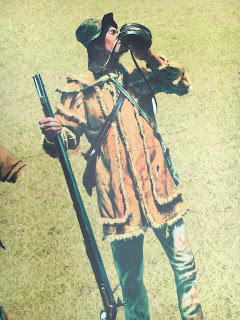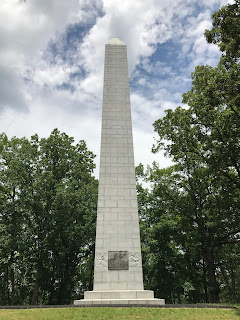Our first stop, after a 14-hour drive from Tulsa to Knoxville on the first day, and a 3-hour drive to South Carolina on the second, was the Kings Mountain National Military Park. I have been promising to write about Kings Mountain for a long time but was hoping to actually visit the battle site first.
For years I have read both facts and folklore about my ancestor, Jacob Castle. It was often mentioned that he took part in the Battle of Kings Mountain, but until recently I didn't know where that information came from. Then I found the application of his son Bazle for his own Revolutionary War pension, in which he stated that he remained at home in southwestern Virginia while his father Jacob "went with the Virginia Volunteers to South Carolina, and was under Campbell at the battle of Kings Mountain, in consequence of which he [Bazle] had to stay at home until his [Jacob's] return in the winter of 1780 in the month of February" [1781].
 |
| Bazle Castle's application for a Revolutionary War pension, including statement that his father was at Kings Mountain |
I didn't realize that Kings Mountain was such a big deal. We've all heard about Lexington and Concord, Bunker Hill and Yorktown, but who has ever heard of Kings Mountain? And yet, Thomas Jefferson, writing in 1822, called the battle "the joyful annunciation of that turn of the tide of success which terminated the Revolutionary War, with the seal of our independence." After years of battling the British to a draw (or losing) in the Northern states, the victory at Kings Mountain discouraged British plans for the Southern states and spelled the beginning of the end of the Revolutionary War.
And it all began with a boastful threat by a British major by the name of Patrick Ferguson.
Patrick Ferguson's title was British Inspector of Militia for the Southern Provinces. His job was to recruit and train Loyalists--those colonists that were still loyal to the British crown. Believing that the Southern states were predominantly Loyalist, British General Cornwallis sent Ferguson to organize the Loyalist militia in the South. He hoped to consolidate his position there in order to put pressure on the American forces elsewhere.
Ferguson was a soldier through and through, disciplined and for the most part, honorable. He was also considered the best marksman in the British Army. At the Battle of Brandywine in 1777 he had the opportunity to fire at an American officer and wouldn't take the shot because he would have shot the officer in the back. The officer was George Washington. Later in the same battle, his right elbow was shattered by a musket ball, and he never regained full use of it. His response to this disaster was to learn to shoot just as well with his left hand.
There was much to admire about Patrick Ferguson, but his training and talent also made him arrogant. He despised the American militia forces for their unorganized way of fighting "Indian style." In skirmishes in North Carolina with the militia led by Colonel Charles McDowell, the Americans had ambushed Ferguson's troops, and then retreated to their homes over the Blue Ridge and Appalachian Mountains. Ferguson sent them a message via a captured Patriot militiaman: "If you do not desist your opposition to the British Arms, I shall march this army over the mountains, hang your leaders, and lay waste your country with fire and sword."
As soon as Isaac Shelby (future governor of Kentucky) got the message, he rode to the home of John Sevier (future governor of Tennessee), and together they made plans to take the battle to Ferguson. They sent messengers to North Carolina and to militia leaders, Arthur and William Campbell, in Virginia. They agreed to meet at Sycamore Shoals (near today's Elizabethton, TN) on September 25. Shelby brought over 200 men, as did Sevier. William Campbell brought 400 men who had mustered at Abingdon, VA (about 30 miles from Castle's Woods.) With the addition of McDowell's men who had retreated to this area following the skirmish with Ferguson, this force consisted of one thousand men--some on horseback, some on foot--who set off on September 26 to find Patrick Ferguson and engage him far from the homes he had threatened.
As Randell Jones, author of A Guide to the Overmountain Victory National Historic Trail, points out: "This was not an army in the strictest sense of the word. All the men were civilians; none was a Continental soldier, although most were experienced militiamen, having fought for years against Cherokees, Chickamaugas, Shawnees, and tories...The men were all skilled hunters and woodsmen. They were fighters, too, but they lacked the strict discipline of a military unit." This is why Patrick Ferguson looked down on them, but you also have to remember that Ferguson's men were militia, too.
Okay, this is one of my favorite parts, because it's a connection to the other side of my family. On September 27 the thousand-man force began to climb Roan Mountain and found themselves in a meadow covered with snow that they described as "shoe-mouth deep." I laughed out loud when I read that for the first time. That was one of my grandpa Weaver Smith's favorite expressions. (See Grandparent #1: Weaver Harris Smith) I always thought it expressed perfectly a depth of two or three inches. The original home of my Smiths is such a mystery. It makes me wonder if that expression comes from the Overmountain region, or just the South in general. Up until I read that I had never heard anybody else use it, except my grandpa.
Also at Roan Mountain roll is called, and it is discovered that two men, obviously with Loyalist leanings, have deserted to warn Ferguson that the Overmountain men are looking for him. They expect to find Ferguson at Gilbert Town in southern North Carolina, but when they reach there, he is gone. They at first head west, away from Kings Mountain, thinking they are following Ferguson, but soon get news that he is headed east.
Again quoting Randell Jones, "As the Patriots continued riding east, they learned from local residents that Ferguson was encamped atop Little Kings Mountain. It was a promontory rising about 60 feet above the surrounding terrain [more a hill than a mountain, my words]. The open area at the top was oblong, a few hundred yards in length and narrowing from 120 to 60 yards across...Ferguson had selected his campsite on top of the mountain believing that the high ground afforded him a military advantage should the Patriot militia catch up to him." At Cowpens, just west of Kings Mountain, on the evening of October 6, the Overmountain Men chose their best 900 armed and mounted men, and they pushed on to meet Ferguson's 1,000-man Loyalist army atop Kings Mountain.
Today's Kings Mountain National Military Park is wooded and peaceful. We learned from our visit that the sides of the promontory would have looked different at the time of the battle. Where today there are many mature trees, saplings, and underbrush, in 1780 the existing trees would have been very old and very big, blocking the sunlight from reaching below their canopies. There would have been no saplings or underbrush. While the trees might have offered some cover, there was plenty of space between the trees for the militia on both sides to meet in battle.
The predominant weapon on both sides of the Revolutionary War was the Brown Bess muzzle-loading musket, because it could be loaded and fired three to four times in a minute, although it was very inaccurate. Lines of soldiers in open-field combat had an advantage because they could fire together and quickly at an oncoming force and then use the attached bayonet to "finish the job." In the battle at Kings Mountain the Loyalist forces were carrying Brown Bess muskets. However, the Overmountain Men were carrying long rifles that they used at home for hunting and protection. According to the National Park brochure for the Kings Mountain park, Kings Mountain was the "only battle in the war in which the primary weapon of the patriot forces was the American long rifle." The long rifle took a minute to load, but was much more accurate than the musket.
 |
| Overmountain Man at Kings Mountain NP |
In the conditions at Kings Mountain, the long rifle was an advantage. The Loyalist forces coming down the mountain to meet the Patriot forces tended to shoot over the Patriots' heads, although when they got close enough, their bayonets were deadly. The Patriots were forced to retreat, and the Loyalists returned to the top of the hill. The Patriots again made an advance up the hill, "taking deadly aim with their hunting rifles and claiming victim after victim" [Randell Jones]. On their third advance, they took the top of the mountain.
At this point Patrick Ferguson rode toward the Patriot lines, probably in an attempt to escape capture, and was shot by one of the Patriot militiamen. As he fell from the saddle, his foot caught in the stirrup, and his horse dragged him around as more Patriots (at least 6 or 7) fired into his body. At the death of Ferguson, the Loyalists quickly surrendered. Along with Ferguson, 120 Loyalists died, and the rest were wounded or captured. The Patriot losses were 28 killed, 62 wounded.
Heading back toward Gilbert Town with their prisoners, the Patriots stop along the way at Biggerstaff's Plantation for a quick trial of the Loyalist prisoners. They condemn 30 to death and hang 9 of them before the proceedings are brought to a halt by Isaac Shelby.
The victory of the Overmountain Men at Kings Mountain altered the plans of General Cornwallis. Instead of advancing into North Carolina, as was his original plan, he retreated to South Carolina for the winter. No longer could he depend on a large number of Loyalists in the South, as the events at Kings Mountain encouraged Patriot sentiment in the South and discouraged Loyalist support. British General Sir Henry Clinton, overall commander in North America, remarked that Kings Mountain was "the first link in a chain of evils...that ended in the total loss of America."
The battlefield was untouched until 1815 when Dr. William McLean initiated an effort to commemorate the battle. This included cleanup of the site, reburying of the bones of the dead, and dedication of a marker honoring four of Dr. McLean's neighbors from North Carolina and Patrick Ferguson. A monument was erected in 1880, and another in 1909. In 1930 on the 150th anniversary of the battle a marker was placed at Patrick Ferguson's cairn on the mountain, which reads "This memorial is from the citizens of the United States in token of their appreciation of the bonds of friendship and peace between them and the citizens of the British Empire."
 |
| 1909 Monument |
 |
| Patrick Ferguson marker erected 1930 |
My brother and I mentioned often on this trip that it's weird how often members of the two sides of our family, our dad's and our mom's, were living in the same areas and engaged in the same events. Isaac Shelby, one of the militia leaders at Kings Mountain and future governor of Kentucky, commanded our paternal ancestor Jacob Castle at Kings Mountain and our maternal ancestor William Whitley at the Battle of the Thames, which Shelby survived. He is buried at his home in Kentucky, Traveller's Rest, less than 30 miles from William Whitley's home at Sportsman's Hill.
 |



History have many things hidden in it and such post lets me explore it and know about it. Thank you for sharing this lovely post with us.
ReplyDeletewonderfully written. I am finishing a historical novel about Jacob Castle and your posts have been so very helpful! Email me at lsandow@hotmail.com if you interested in a copy.
ReplyDelete